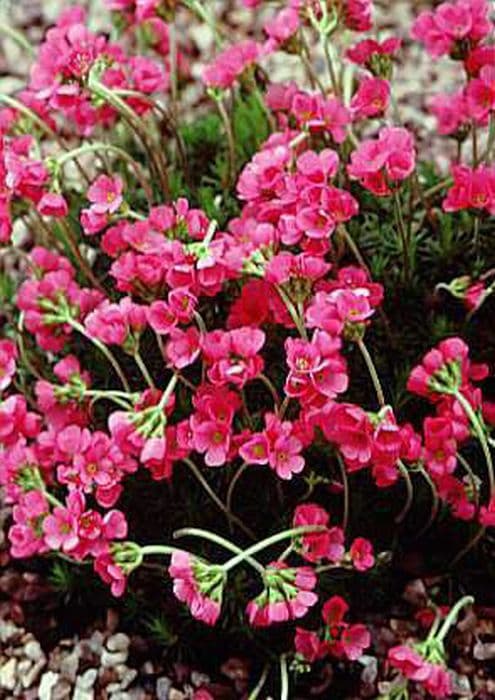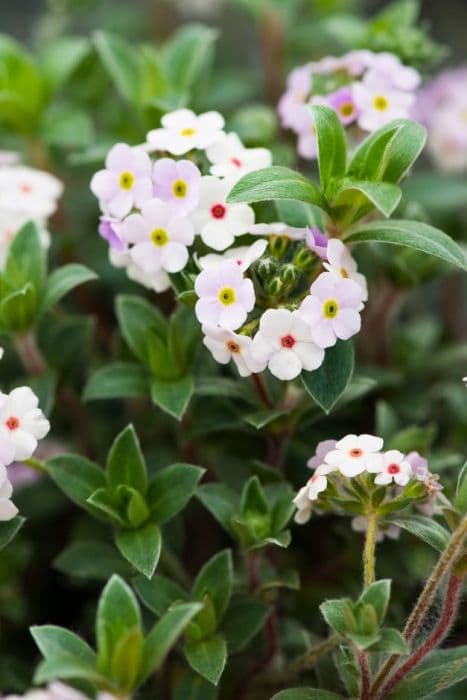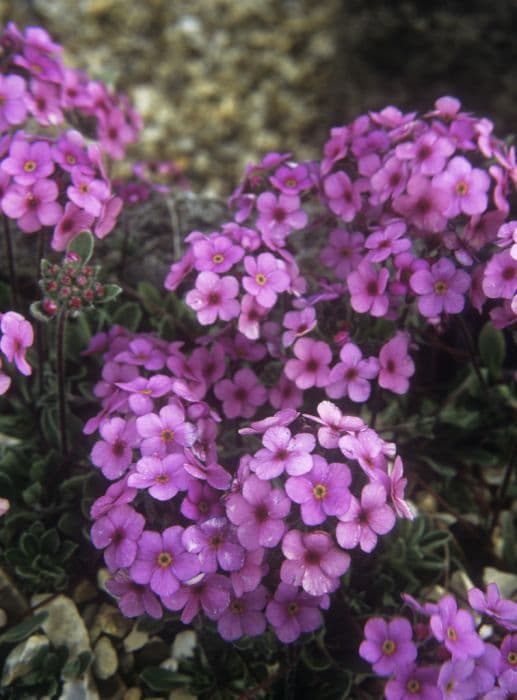Auricula Primula auricula 'Mazetta Stripe' (Au/s/st)

ABOUT
Primula auricula 'Mazetta Stripe', commonly known as 'Striped Auricula', is a striking flowering plant that is known for its unique and ornamental appearance. The leaves of the auricula are typically a lush green, forming an attractive, compact rosette at the base from which flower stems arise. The foliage may have a slightly fleshy texture, which adds to the overall visual interest of the plant. The most captivating feature of the Striped Auricula is its flowers. Each blossom is composed of a circular arrangement of rounded petals, which can range in color from deep purples and blues to bright yellows and reds. However, what sets the 'Mazetta Stripe' variety apart is the presence of bold stripes marking each petal. These stripes can vary in color, often contrasting vividly against a lighter or darker petal background. The stripes give the appearance of intricate detailing on the flowers, which makes this plant highly sought after for gardeners who appreciate unique botanical characteristics. The flowers are borne in clusters, held aloft on stems that rise above the foliage. This gives the plant a striking visual presence when in full bloom, as the striped flowers create a canopy of color. The 'Mazetta Stripe' is prized for its showy blossoms that can captivate onlookers and create a focal point in gardens. The heart of each flower typically features a central zone known as the "eye," which may be of a contrasting color, adding further depth to the flower's appearance. Overall, the Striped Auricula is a cherished ornamental plant that is admired for its show-stopping flowers with their distinctive stripes, as well as its lush, green rosette of leaves. It's a plant that embodies both artistry and grace, making it a beloved choice among those looking to add a touch of elegance to their planting spaces.
About this plant
 Names
NamesFamily
Primulaceae
Synonyms
Bear's Ear, Auricula, Mountain Cowslip
Common names
Primula auricula 'Mazetta Stripe' (Au/s/st).
 Toxicity
ToxicityTo humans
Primula auricula, commonly known as Auricula, is not considered highly toxic to humans. However, some people might experience mild skin irritation due to contact with its sap because of the presence of primin, a chemical compound found in Primula species. Ingesting parts of the Auricula might cause mild stomach upset and gastrointestinal discomfort in some individuals. It is advisable to handle plants with care and wash hands after contact. If any parts of the plant are ingested, and symptoms appear, it is recommended to seek medical advice.
To pets
Auricula is not known to be highly toxic to pets. Nevertheless, its sap contains primin which can cause mild skin irritation in sensitive individuals, and if pets chew on the plant, they could potentially experience mild gastrointestinal discomfort, including symptoms such as vomiting or diarrhea. If you suspect your pet has ingested any part of the Auricula and is showing signs of distress, it is best to consult with a veterinarian.
 Characteristics
CharacteristicsLife cycle
Perennials
Foliage type
Evergreen
Color of leaves
Green
Flower color
Mixed
Height
6 inches (15 cm)
Spread
6 inches (15 cm)
Plant type
Herb
Hardiness zones
5
Native area
Europe
Benefits
 General Benefits
General Benefits- Ornamental Value: Adds vibrant color and visual interest to gardens with its unique striped flowers.
- Long Blooming: The plant has a lengthy flowering period, offering extended display of blossoms.
- Attracts Wildlife: It can attract butterflies and other pollinators, enhancing biodiversity in the garden.
- Low Maintenance: Known for being easy to care for without requiring excessive attention.
- Hardiness: Resistant to cold temperatures, making it suitable for a variety of climates.
- Compact Growth: Its petite size allows it to fit well in smaller spaces or rock gardens.
 Medical Properties
Medical PropertiesThis plant is not used for medical purposes.
 Air-purifying Qualities
Air-purifying QualitiesThis plant is not specifically known for air purifying qualities.
 Other Uses
Other Uses```html
- Photography Backdrop: The vibrant colors and patterns of Auricula flowers provide a stunning backdrop for macro photography or portraiture.
- Craft Projects: Dried Auricula flowers can be used for scrapbooking, card making or other paper crafts, adding a touch of natural beauty.
- Educational Tool: Teachers can use Auricula plants to educate students about botany, especially the unique characteristics of alpine flowers.
- Perfumery: Though not commonly used in perfumery, the subtle scent of Auricula flowers could potentially be captured and used in handcrafted perfumes.
- Color Inspiration: Artists and designers may draw inspiration from the rich colors and textures of Auricula petals for their work.
- Culinary Decoration: While not commonly eaten, the petals can be used as a decorative element on desserts or in salad garnishes.
- Theme Gardens: Auriculas can be grown as part of a specific garden theme, such as a Shakespearean or Elizabethan garden, to create an authentic historical ambiance.
- Floral Arrangements: Fresh or dried Auricula flowers can be included in floral arrangements to add a touch of elegance and rarity.
- Victorian Potted Displays: Auriculas can be potted in traditional Victorian auricula theatres, which are unique tiered display cases for these types of flowers.
- Specialty Nurseries: Collectors of rare plants may feature Auriculas as a specialty item in boutique plant nurseries.
Interesting Facts
 Feng Shui
Feng ShuiThe auricula is not used in Feng Shui practice.
 Zodiac Sign Compitability
Zodiac Sign CompitabilityThe auricula is not used in astrology practice.
 Plant Symbolism
Plant Symbolism- Unique Beauty: The ‘Mazetta Stripe’ Auricula is known for its unique and striking striped petals, symbolizing the beauty in individuality and distinctive characteristics.
- Rarity: As a cultivar with specific and uncommon patterns, it exemplifies rarity and can represent something precious and uncommon.
- Delicacy: The Auricula’s delicate structure and petals can signify delicacy and the care needed to nurture something fragile.
- Patience: Given their specific growing requirements, auriculas symbolize patience and the rewards of attentive cultivation.
- Cherished Friendship: In the language of flowers, the auricula is sometimes associated with friendship, due to its warm appearance and the way it’s frequently shared and admired among gardening enthusiasts.
 Water
WaterFor the Auricula Primrose, it's essential to keep the soil consistently moist but not waterlogged. Water the plant when the top inch of soil feels dry to the touch, which typically could be every few days depending on the climate and indoor conditions. Use lukewarm water and aim to water at the base of the plant, avoiding the leaves to prevent fungal diseases. An average watering amount might be around 8-16 ounces of water per week, but this can vary widely with environmental conditions, so it's best to check the soil moisture level regularly.
 Light
LightThe Auricula Primrose prefers bright, indirect light. It can tolerate some morning sunlight but should be protected from strong, direct afternoon rays which can scorch its leaves. A north-facing or east-facing window would be an ideal spot for this plant, providing it with the gentle light it thrives in.
 Temperature
TemperatureAuricula Primrose is comfortable in temperatures ranging from 50 to 75 degrees Fahrenheit. Avoid exposing the plant to temperatures below 40 degrees Fahrenheit as it can be harmful. The ideal range for robust growth and flowering lies between 60 and 70 degrees Fahrenheit.
 Pruning
PruningPrune the Auricula Primrose to remove dead or yellowing leaves and spent flowers to encourage new growth and improve air circulation. This should be done after blooming, generally in the late spring or early summer. Deadheading, or removing faded flowers, can be done regularly throughout the blooming season to maintain the plant's appearance.
 Cleaning
CleaningAs needed
 Soil
SoilAuricula's best soil mix is well-draining with high organic matter; a blend with equal parts peat, loam, and perlite or sand works well. The soil pH should range from slightly acidic to neutral, approximately 5.5 to 7.0.
 Repotting
RepottingAuriculas should be repotted annually. The best time to repot is in the late summer after flowering or in early fall.
 Humidity & Misting
Humidity & MistingAuriculas prefer moderate humidity levels, ideally ranging between 50% to 60%. Avoid environments with very dry air or overly moist conditions.
 Suitable locations
Suitable locationsIndoor
Place in bright, indirect light; water moderately.
Outdoor
Plant in partial shade, sheltered from harsh elements.
Hardiness zone
4-8 USDA
 Life cycle
Life cycleThe 'Mazetta Stripe' Auricula, A primula variety, begins its life as a seed planted in well-draining soil from late winter to early spring. It then germinates, often requiring light for germination, and sprouts into a seedling, a process that may take anywhere from two to four weeks under the right conditions. As it grows, the Auricula plant develops a rosette of leaves and, after reaching maturity, it typically blossoms in early to late spring, boasting striking striped flowers that attract pollinators. The plant enters a vegetative phase in the summer months where it continues to grow foliage, and it may go semi-dormant in intense heat. In the following spring, the cycle repeats with the plant producing new flowers each year for several years before it may eventually slow down or cease flowering as it reaches the end of its lifespan. Propagation, to ensure continued growth of new plants, is commonly achieved through division or cuttings, rather than waiting for the plant to self-seed.
 Propogation
PropogationPropogation time
Spring-Early Summer
The most popular method of propagation for Auricula Primroses, which includes the Primula auricula 'Mazetta Stripe', is by offset division. This is typically done in late summer after the flowering period when the plant is less actively growing. Offsets are small rosettes that form at the base of the parent plant; they can be gently teased away from the main plant using a clean and sharp knife or garden tool. After separation, offsets should be potted individually in well-draining potting mix, and placed in a sheltered location with indirect light to establish their roots. Water should be provided sparingly to encourage the new roots without causing rot, ensuring that the potting mix remains lightly moist but not waterlogged. This method is highly effective as it maintains the varietal characteristics of the parent plant and usually results in flowering plants within a year.









